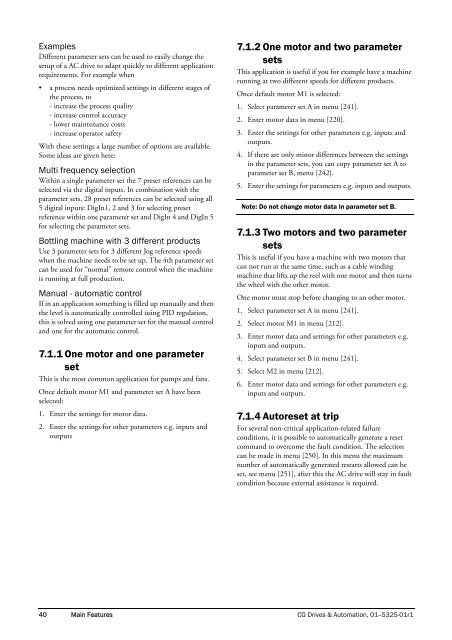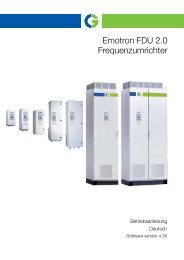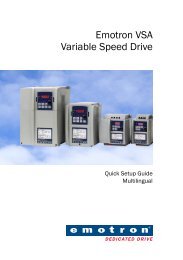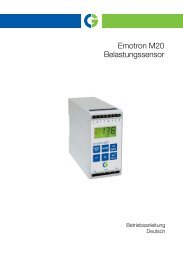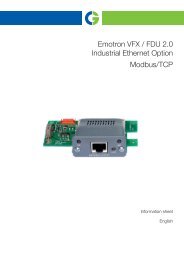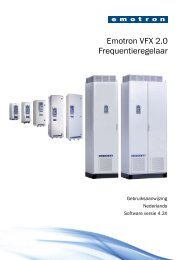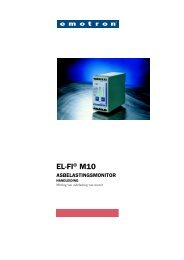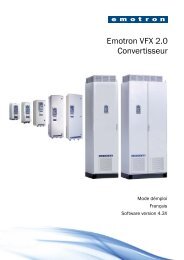Instruction manual - Emotron
Instruction manual - Emotron
Instruction manual - Emotron
You also want an ePaper? Increase the reach of your titles
YUMPU automatically turns print PDFs into web optimized ePapers that Google loves.
Examples<br />
Different parameter sets can be used to easily change the<br />
setup of a AC drive to adapt quickly to different application<br />
requirements. For example when<br />
• a process needs optimized settings in different stages of<br />
the process, to<br />
- increase the process quality<br />
- increase control accuracy<br />
- lower maintenance costs<br />
- increase operator safety<br />
With these settings a large number of options are available.<br />
Some ideas are given here:<br />
Multi frequency selection<br />
Within a single parameter set the 7 preset references can be<br />
selected via the digital inputs. In combination with the<br />
parameter sets, 28 preset references can be selected using all<br />
5 digital inputs: DigIn1, 2 and 3 for selecting preset<br />
reference within one parameter set and DigIn 4 and DigIn 5<br />
for selecting the parameter sets.<br />
Bottling machine with 3 different products<br />
Use 3 parameter sets for 3 different Jog reference speeds<br />
when the machine needs to be set up. The 4th parameter set<br />
can be used for “normal” remote control when the machine<br />
is running at full production.<br />
Manual - automatic control<br />
If in an application something is filled up <strong>manual</strong>ly and then<br />
the level is automatically controlled using PID regulation,<br />
this is solved using one parameter set for the <strong>manual</strong> control<br />
and one for the automatic control.<br />
7.1.1 One motor and one parameter<br />
set<br />
This is the most common application for pumps and fans.<br />
Once default motor M1 and parameter set A have been<br />
selected:<br />
1. Enter the settings for motor data.<br />
2. Enter the settings for other parameters e.g. inputs and<br />
outputs<br />
7.1.2 One motor and two parameter<br />
sets<br />
This application is useful if you for example have a machine<br />
running at two different speeds for different products.<br />
Once default motor M1 is selected:<br />
1. Select parameter set A in menu [241].<br />
2. Enter motor data in menu [220].<br />
3. Enter the settings for other parameters e.g. inputs and<br />
outputs.<br />
4. If there are only minor differences between the settings<br />
in the parameter sets, you can copy parameter set A to<br />
parameter set B, menu [242].<br />
5. Enter the settings for parameters e.g. inputs and outputs.<br />
Note: Do not change motor data in parameter set B.<br />
7.1.3 Two motors and two parameter<br />
sets<br />
This is useful if you have a machine with two motors that<br />
can not run at the same time, such as a cable winding<br />
machine that lifts up the reel with one motor and then turns<br />
the wheel with the other motor.<br />
One motor must stop before changing to an other motor.<br />
1. Select parameter set A in menu [241].<br />
2. Select motor M1 in menu [212].<br />
3. Enter motor data and settings for other parameters e.g.<br />
inputs and outputs.<br />
4. Select parameter set B in menu [241].<br />
5. Select M2 in menu [212].<br />
6. Enter motor data and settings for other parameters e.g.<br />
inputs and outputs.<br />
7.1.4 Autoreset at trip<br />
For several non-critical application-related failure<br />
conditions, it is possible to automatically generate a reset<br />
command to overcome the fault condition. The selection<br />
can be made in menu [250]. In this menu the maximum<br />
number of automatically generated restarts allowed can be<br />
set, see menu [251], after this the AC drive will stay in fault<br />
condition because external assistance is required.<br />
40 Main Features CG Drives & Automation, 01--5325-01r1


